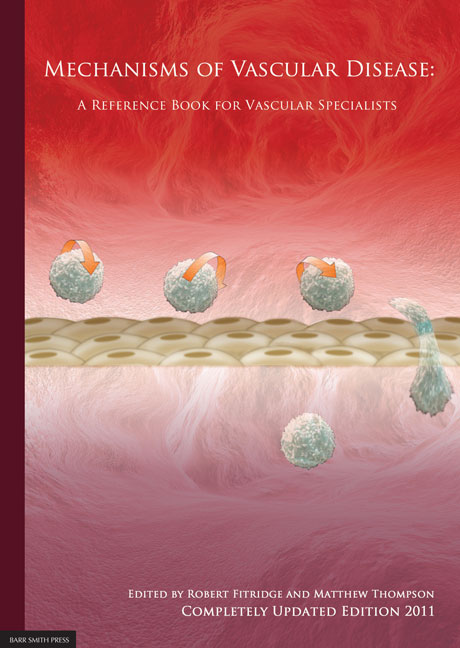Book contents
- Frontmatter
- Contents
- List of Contributors
- Detailed Contents
- Acknowledgements
- Abbreviation List
- 1 Endothelium
- 2 Vascular smooth muscle structure and function
- 3 Atherosclerosis
- 4 Mechanisms of plaque rupture
- 5 Current and emerging therapies in atheroprotection
- 6 Molecular approaches to revascularisation in peripheral vascular disease
- 7 Biology of restenosis and targets for intervention
- 8 Vascular arterial haemodynamics
- 9 Physiological Haemostasis
- 10 Hypercoagulable States
- 11 Platelets in the pathogenesis of vascular disease and their role as a therapeutic target
- 12 Pathogenesis of aortic aneurysms
- 13 Pharmacological treatment of aneurysms
- 14 Pathophysiology of Aortic dissection and connective tissue disorders
- 15 Biomarkers in vascular disease
- 16 Pathophysiology and principles of management of vasculitis and Raynaud's phenomenon
- 17 SIRS, sepsis and multiorgan failure
- 18 Pathophysiology of reperfusion injury
- 19 Compartment syndromes
- 20 Pathophysiology of pain
- 21 Post-amputation pain
- 22 Treatment of neuropathic pain
- 23 Principles of wound healing
- 24 Pathophysiology and principles of varicose veins
- 25 Chronic venous insufficiency and leg ulceration: Principles and vascular biology
- 26 Pathophysiology and principles of management of the diabetic foot
- 27 Lymphoedema – Principles, genetics and pathophysiology
- 28 Graft materials past and future
- 29 Pathophysiology of vascular graft infections
- Index
21 - Post-amputation pain
Published online by Cambridge University Press: 05 June 2012
- Frontmatter
- Contents
- List of Contributors
- Detailed Contents
- Acknowledgements
- Abbreviation List
- 1 Endothelium
- 2 Vascular smooth muscle structure and function
- 3 Atherosclerosis
- 4 Mechanisms of plaque rupture
- 5 Current and emerging therapies in atheroprotection
- 6 Molecular approaches to revascularisation in peripheral vascular disease
- 7 Biology of restenosis and targets for intervention
- 8 Vascular arterial haemodynamics
- 9 Physiological Haemostasis
- 10 Hypercoagulable States
- 11 Platelets in the pathogenesis of vascular disease and their role as a therapeutic target
- 12 Pathogenesis of aortic aneurysms
- 13 Pharmacological treatment of aneurysms
- 14 Pathophysiology of Aortic dissection and connective tissue disorders
- 15 Biomarkers in vascular disease
- 16 Pathophysiology and principles of management of vasculitis and Raynaud's phenomenon
- 17 SIRS, sepsis and multiorgan failure
- 18 Pathophysiology of reperfusion injury
- 19 Compartment syndromes
- 20 Pathophysiology of pain
- 21 Post-amputation pain
- 22 Treatment of neuropathic pain
- 23 Principles of wound healing
- 24 Pathophysiology and principles of varicose veins
- 25 Chronic venous insufficiency and leg ulceration: Principles and vascular biology
- 26 Pathophysiology and principles of management of the diabetic foot
- 27 Lymphoedema – Principles, genetics and pathophysiology
- 28 Graft materials past and future
- 29 Pathophysiology of vascular graft infections
- Index
Summary
INTRODUCTION
The phenomenon of pain in a missing limb has puzzled patients, doctors and the lay public for centuries. In the 16th century the French military surgeon Ambroise paré published a medical description of the enigmatic affliction, while in the 17th century the great philosopher Rene Descartes looked at its potential pathophysiology. The most famous ‘first’ description of the condition is attributed to the great neurologist charles Bell, but it was only in the later part of 19th century, that the US military surgeon Silas Weir Mitchell introduced the term ‘phantom limb’: ‘There is something almost tragical, something ghastly, in the notion of these thousands of spirit limbs, haunting as many good soldiers, and every now and then tormenting them …’
We now know that post-amputation syndromes can occur with any amputated body part apart from limbs e.g. breast, tongue, teeth, genitalia and even inner organs such as the rectum.
CLASSIFICATION AND INCIDENCE OF POST-AMPUTATION PAIN SYNDROMES
Following amputation (or deafferentiation injury such as brachial plexus avulsion) a number of phenomena can develop, which require differentiation.
Stump Pain
Stump pain is pain localized to the site of amputation. Stump pain can be acute (usually nociceptive) or chronic (usually neuropathic). Stump pain is most common in the immediate post-operative period. The overall incidence of chronic stump pain is in the range of 45%. The incidence of early stump pain is increased by the presence of severe pre-amputation pain and severe acute stump pain.
- Type
- Chapter
- Information
- Mechanisms of Vascular DiseaseA Reference Book for Vascular Specialists, pp. 389 - 400Publisher: The University of Adelaide PressPrint publication year: 2011

